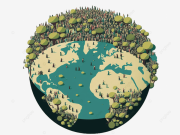Welcome to our blog, where we delve into one of the most pressing challenges of our time: climate change. Join us as we explore the causes and impacts of climate change, discuss the urgency of collective action, and highlight innovative solutions to mitigate its effects. From understanding the science behind climate change to exploring individual and global efforts, we’ll shed light on the importance of addressing this crisis for a sustainable future.
Understanding Climate Change:
1.1 The Science of Climate Change:
Explaining the greenhouse effect and the role of human activities in increasing greenhouse gas emissions.
Discussing the scientific consensus on climate change and the evidence supporting it.
1.2 Causes of Climate Change:
Examining the primary sources of greenhouse gas emissions, including burning fossil fuels, deforestation, and industrial processes.
Addressing the role of land use change, agriculture, and waste management in contributing to climate change.
1.3 Impacts of Climate Change:
Exploring the consequences of climate change on ecosystems, biodiversity, and natural resources.
Discussing the effects on human health, food security, water availability, and vulnerable communities.
Mitigation Strategies:
2.1 Transitioning to Renewable Energy:
Highlighting the importance of shifting from fossil fuels to renewable energy sources.
Discussing the progress and potential of solar, wind, hydro, and geothermal energy technologies.
2.2 Energy Efficiency and Conservation:
Exploring the role of energy efficiency measures in reducing greenhouse gas emissions.
Discussing initiatives for promoting energy conservation in industries, buildings, and transportation.
2.3 Sustainable Land Use and Forest Conservation:
Addressing the significance of sustainable agriculture, reforestation, and forest conservation in mitigating climate change.
Discussing the role of protecting and restoring ecosystems, including peatlands and mangroves.
Adaptation and Resilience:
3.1 Building Climate Resilient Infrastructure:
Discussing the importance of adapting infrastructure to withstand climate-related hazards.
Highlighting examples of resilient design, such as flood-resistant buildings and climate-smart urban planning.
3.2 Enhancing Disaster Preparedness:
Exploring strategies for improving early warning systems and emergency response mechanisms.
Addressing the need for community engagement and capacity building in disaster risk reduction.
3.3 Climate Change and Human Health:
Examining the health impacts of climate change, such as increased disease transmission and heat-related illnesses.
Discussing the importance of public health measures and climate-resilient healthcare systems.
International Cooperation and Policy:
4.1 The Paris Agreement:
Exploring the goals and significance of the Paris Agreement in addressing climate change.
Discussing international efforts to reduce greenhouse gas emissions and promote climate resilience.
4.2 Carbon Pricing and Market Mechanisms:
Addressing the role of carbon pricing as an economic incentive to reduce emissions.
Discussing market mechanisms like emissions trading and carbon offsetting.
4.3 Role of Governments and Policymaking:
Highlighting the importance of strong policies and regulations to drive climate action.
Discussing successful examples of national and regional climate policies.
Individual and Collective Action:
5.1 Sustainable Lifestyle Choices:
Exploring individual actions to reduce carbon footprints, such as energy conservation, waste reduction, and sustainable transportation.
Discussing the importance of consumer choices and supporting sustainable businesses.
5.2 Education and Awareness:
Highlighting the role of education in raising awareness about climate change and fostering environmentally responsible behaviors.
Discussing the importance of climate literacy and empowering individuals to become agents of change.
5.3 Collaboration and Advocacy:
Encouraging collective action through community engagement, grassroots movements, and advocacy.
Discussing the power of collaboration between governments, businesses, civil society, and academia.
Conclusion:
As we conclude our exploration of climate change, we recognize the urgent need for global action to address this crisis. By understanding the science behind climate change, implementing mitigation and adaptation strategies, and fostering individual and collective action, we can work towards a sustainable and resilient future.























